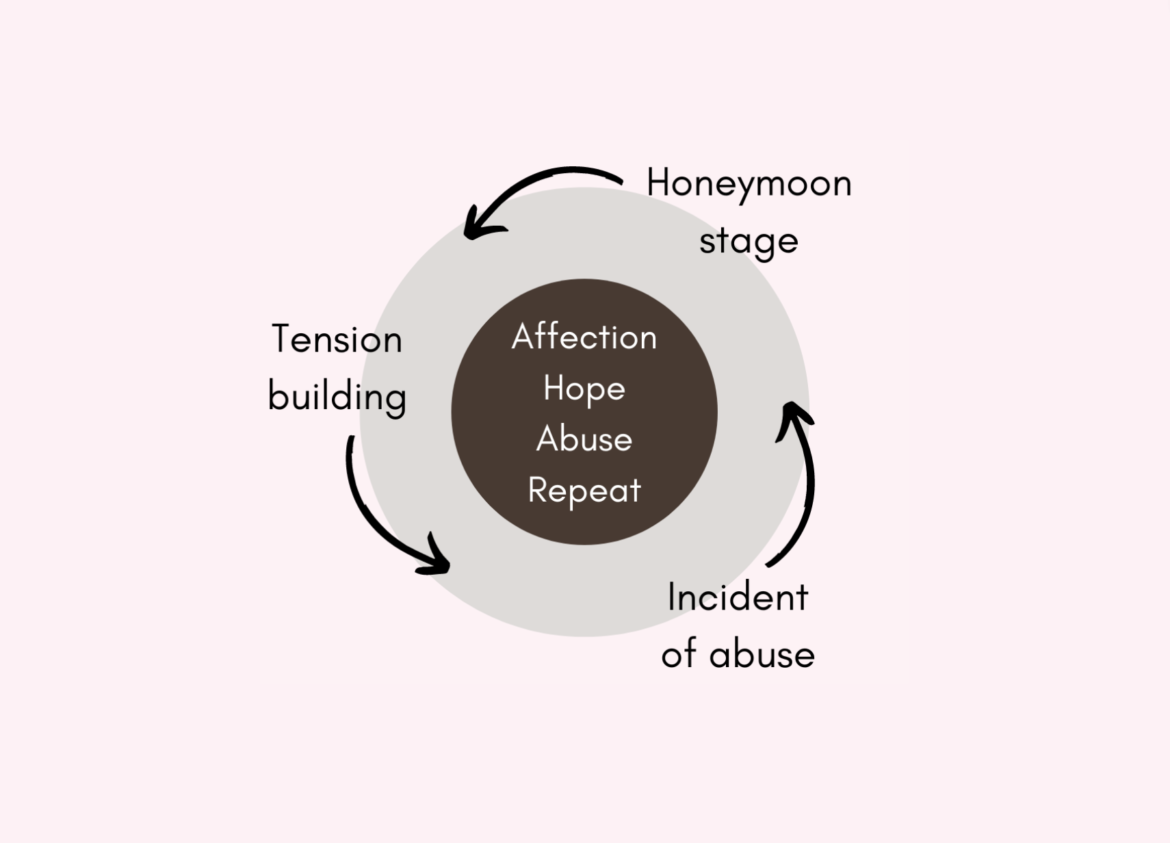
Breaking the Chain: Understanding the Cycle of Abuse
The cycle of abuse is a pattern of behavior that you’ll see in abusive relationships. It is a pattern of behavior that can occur in any type of relationship where one person uses power and control to harm their partner.
It typically involves five stages, which occur in a repeating pattern and can be broken down into three main stages: tension-building, explosion, and honeymoon. Understanding the cycle of abuse can help identify if you are in an abusive relationship and take steps to get out of it.
For the purposes of this example, I will use ‘he’ to refer to the abuser. It’s important to note that abuse can happen to anyone regardless of gender.
Stage one: Tension-building
The first stage of the abuse cycle is the tension-building phase. During this stage, tensions start to build in the relationship, and the abuser may become increasingly irritable, critical, or controlling. He may also start to blame you for his problems and may become possessive or jealous. This stage can last for days, weeks, or even months.
Stage two: Incident phase

The second stage is the incident phase. This is the stage when the abuser lashes out with abuse, whether it’s physical, emotional, sexual, or other forms. You may feel terrified, frozen, confused, and unsafe. It is normal to feel a mix of emotions during the incident phase since his behavior now has shifted from seemingly tender to cruel. He may use violence, threats, or other forms of coercion to control you. He may also use verbal abuse, such as name-calling, belittling, or threatening language. This stage poses the greatest risk, as it can result in serious physical harm and leave the victim with lasting psychological trauma from the emotional abuse.
Stage three: The honeymoon phase

The third stage is the honeymoon phase. After the incident, the abuser may apologize, promise to change, or make excuses for his behavior. He may also offer gifts, affection, or sex as a way of making up. It is also a common tactic for the abuser to shift the blame onto the victim for his behavior, or to manipulate you into believing that you are the only one who can help him change. This is a manipulative tactic that is also abusive, but it may not appear as such because it is more subtle and often combined with displays of tenderness. It is normal to feel confused and unsure about what to believe.
During this stage, you may believe that he will change and the relationship will improve. This happens because abusers are skilled at manipulating their victims through the use of superficial charm, flattery, and by providing what they have deliberately withheld from the victim. This stage is also known as the “calm before the storm” as it creates a false sense of security and hope. The reason he behaves in this way is that he wants to maintain control and keep you emotionally invested in the relationship, preventing you from leaving. It is important to note that this behavior should not be mistaken as a sign of love or affection, but rather as a manipulation tactic to control and maintain power over you. Additionally, it is a selfish way of avoiding feelings of loneliness, boredom, and anything else that he does not want to face within. It is also an incredibly cruel way of behaving since he is not interested in changing and by manipulating you to stay he is consciously willing to continue the cycle of abuse.
Stage four: The calm phase
The fourth stage is the seemingly calm phase. The relationship returns to what seems to be a state of calm, and you may even get a feeling that things are improving for a period of time. You may begin to feel things like hope, happiness, and connection with the abuser. During this stage, he will deliberately be less controlling, and you may feel a sense of relief. This stage can last for days, weeks, or even months. It is usually stages three and four that keep you hooked into this toxic cycle, you may be waiting only for these two stages to arrive because you feel emotionally dependent on whatever little affection the abuser is willing to give to you when it suits him.
Stage five: Repeat
The fifth stage is the repeat phase. The cycle starts all over again with the tension-building phase, and this pattern will repeat itself many times over the course of the relationship. You may feel trapped in this cycle, one part of you wants to leave, and another, stay. Stages three and four give you the false hope that he will and can change or may simply fear what his retaliation will be if you leave.
This cycle may vary from person to person, and it may not always happen in a linear way. You may experience multiple cycles in a single day. If you can recognize yourself here in any way, you are trauma-bonded to your abuser (read “Are you tired of hurting in your relationship? 7 Signs you may be trauma-bonded”).
Here are 10 things you can do in order to cope if you are currently in an abusive relationship:
- Recognizing the patterns of abuse: Understand the dynamics of the relationship and how the abuser uses tactics such as manipulation and control. To learn more about abusive tactics regardless of whether your abuser is a narcissist or not, this article will help you learn more: https://khanselma.com/12-mistakes-you-want-to-avoid-when-dealing-with-a-narcissist/
- Learning about the abuser’s behavior: Understand that the abuser’s behavior is not your fault and that it is not likely to change without significant intervention.
Book recommendations: “Why Does He Do That?: Inside the Minds of Angry and Controlling Men” by Lundy Bancroft and “Men Who Hate Women and the Women Who Love Them: When Loving Hurts and You Don’t Know Why” by Dr. Susan Forward. - Setting boundaries: Communicate your needs and expectations clearly, and make it clear that abusive behavior is not acceptable. Note that abusers don’t care about boundaries and will fight back, but you can still get control back when you stand your ground on topics that are important to you.
- Seeking support: Surround yourself with people who will support and believe you. Seek out old or new friends, talk to colleagues if you work, keep a journal to express your feelings and write down what you are going through, and seek help from domestic violence organizations are some practical things you can do. Do not isolate yourself, it will only make the abuse worse and make you feel worse.
- Developing a safety plan: Identify a safe place to leave, have a phone and money readily available, and have important documents such as identification and proof of address on hand.
- Building self-esteem: Work on building your self-worth, as abuse will erode this, Internal Family Systems Therapy (IFS) which is an evidence-based trauma treatment will help you to heal and rebuild your self-worth. Do things that you love or get back to those hobbies if you can. Remind yourself of a time when you had high self-worth and write down what you used to do and how you used to think at that time. If you can’t think of a time, imagine how you would be, think, feel and act if your self-worth was not under attack by the abuser.
- Practicing self-care: Take care of yourself physically, emotionally, and mentally by engaging in activities that bring you joy and relaxation. Eg. Drinking water, eating something healthy, taking a walk, meeting a friend, meditating, taking a bath, reading a book, or starting a class.
- Being prepared to leave: If the toxic behavior continues, be prepared to leave the relationship, and have a plan in place for your safety and well-being. Make the plan as elaborate as possible, where will you go, how will you get there, how much money do you need to survive and start over if needed, how will you sustain yourself (and kids if necessary) on your own, who can you trust to help you are a few examples.
- Educate yourself about different resources and options available for leaving an unhealthy and dangerous relationship.
- Consider trauma therapy to heal the underlying childhood wounds that may be what is keeping you in this toxic relationship. Trauma therapy will also help you process what you’ve been through and understand the dynamics of the relationship, and how to move forward in a healthy way, you can contact me at www.khanselma.com/contact if you want to book your first appointment or ask me anything.
Healing from abuse can be the key to leaving it and beginning healing. One of these therapies is the evidence-based treatment method IFS (Internal Family Systems Therapy). IFS works with different parts within you, in abusive relationships, you will usually notice one part that wants to stay in the relationship and one that wants to leave. In IFS, you are guided to listen to these parts within you and help them get the resolve they are seeking. These are usually the younger parts of you who need to be released of the burdens they carry due to childhood wounds. IFS will help you resolve your childhood traumas, release stuck energy from your body, and give your body and mind long-awaited relief. IFS also helps you to finally put the past in the past and gives you a real chance of living in the present, being more at ease with your body and mind.
Together, we can begin your healing journey, and through the use of online therapy, we can work together no matter where you are located. Feel free to contact me at https://khanselma.com/contact/. I always answer all my emails within 24 hours.
Do you know someone who can benefit from reading this article? Share it with them.
With love,
Selma


Leave a Reply